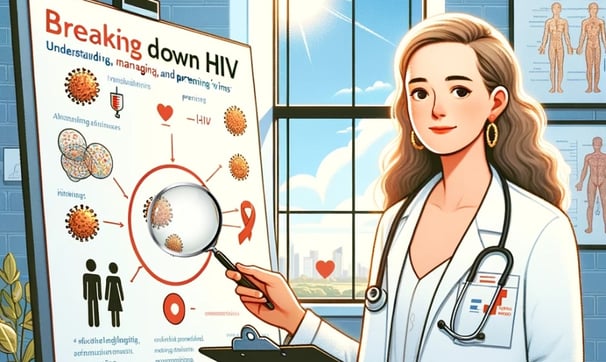Breaking Down HIV: Understanding, Managing, and Preventing the Virus
EDUCATION


Dive into a guide on HIV, focusing on understanding, managing, and preventing the virus. Learn about symptoms, testing, and treatment options like antiretroviral therapy.
Breaking Down HIV: Understanding, Managing, and Preventing the Virus
Human Immunodeficiency Virus (HIV) is a virus that attacks the immune system and, if left untreated, can lead to Acquired Immunodeficiency Syndrome (AIDS). Understanding HIV is crucial in managing and preventing its spread.
What is HIV?
HIV targets the immune system, particularly CD4 cells (T cells), which help the immune system fight off infections. Untreated, HIV reduces the number of these cells, making the person more vulnerable to other infections and diseases. HIV is transmitted through bodily fluids such as blood, semen, vaginal and rectal fluids, and breast milk.
Symptoms of HIV
In the initial stages, HIV infection may cause flu-like symptoms within 2-4 weeks after the virus enters the body. These symptoms can last for a few days or several weeks. As the infection progresses, the immune system becomes severely damaged, leading to more serious symptoms and infections.
Diagnosis and Testing
HIV is diagnosed through various tests that detect antibodies, antigens, or the virus itself. The most common is the antibody/antigen test, which can detect HIV infection 18 to 45 days after exposure. Early diagnosis is key, and regular testing, like those offered by STDCheck.com, is crucial, especially for those with risk factors.
Treatment Options
While there's no cure for HIV, it can be managed effectively with antiretroviral therapy (ART). ART involves taking a combination of HIV medicines every day. ART can’t cure HIV, but it helps people with HIV live longer, healthier lives and reduces the risk of HIV transmission.
Prevention Strategies:
Consistent use of condoms during sex.
Pre-exposure prophylaxis (PrEP) for people at high risk of HIV.
Post-exposure prophylaxis (PEP) if you think you’ve recently been exposed to HIV.
Regular testing and open communication with sexual partners about HIV status.
Living with HIV
Living with HIV today is vastly different than it was decades ago, thanks to advances in medical science. People with HIV who are on effective treatment can live long, healthy lives and have effectively no risk of transmitting HIV to their HIV-negative partners through sex.
Conclusion
HIV, once considered a fatal disease, is now a manageable chronic condition with proper treatment and care. Awareness, regular testing through reliable sources like STDCheck.com, and preventive measures are crucial in the fight against HIV. With continued research and advancements in treatment, the outlook for those living with HIV continues to improve.
